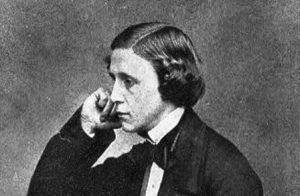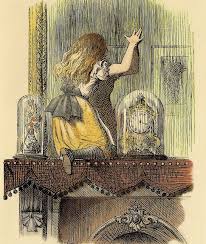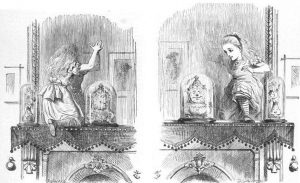Lewis Carroll has always come up with something new and something fresh under this literary firmament and hence, another literary produce of immense excellence is this book by him, “through the looking glass “.

Generally, the genre he follows is that of nonsense verse or nonsense literature rather than black humour or tragic comedy at times. His command over language is something really out of the box and here we can summarize his literary composition, “Through the looking glass”.
Table of Contents
Chapters One to Three of Through the Looking Glass
The central character Alice talks to her pet kitten in a half sleepy rather drowsy state about the world on the other side of the mirror that is the – “ through the looking glass“.
In this chapter, there is obfuscation about the dream and reality of the plot and the narrative. This contrast is mirrored well through the conversation of Alice and her pet kitten.

The garden of live flowers mirror the personification of flora and puts emphasis on the natural beauty and its effects upon young minds as well.
The aesthetics are shown clearly through this chapter when Alice talks to the flowers which are personified and that too in clear English.
Through the Looking Glass Analysis
The looking glass insects and along with the progression of the narrative we can feel the author’s harmony with nature and that too in quite a fancy and fascinating version that can stir up a kid’s mind and can make any other layman think differently and be more imaginative.

Here Alice explores the flora, excavates the fauna and unravels the beauty of nature. She looks into the natural world from a different perspective. She becomes a witness to the natural phenomena happening in the surroundings.
Chapters Four to Six of Through the Looking Glass
This chapter is all about metaphors that describe the inversion effect. The mirror image effect is being shown as the twins whom Alice approaches.
Alice here is active, and interactive and sings poems as well. The White Queen makes us think about the bridge between the past, the present, and the future.

The character’s interaction with the Queen is all indicative of the flow of time and that time is not moving back, rather we all are travelling forward with the passage of time.
The concept of structuring a name with a proper meaning is what we conceive from the idea of Humpty and Dumpty in this chapter of the text. The interplay of words and languages here is important to be looked at.
Through the Looking Glass Summary: Chapters Seven and Eight
The Lion and the Unicorn are about fancy, imagination, and dreams and it is also about Alice’s childhood memories coming true. She tends to see the world from a different angle.
With the progression of the narrative, the fictional characters appear to be true and the character of Alice which gains all salience and centrality also matures enough with this literary progression.
Chapters Nine to Twelve
In the game of chess per se, Alice the central character becoming the queen and so on and so forth finally reflects the difference between the real world and the ideal world that is the glass world.
Conclusion
The entire story, the entire composition is not only about Alice’s adventures but is also the author’s mind unraveling certain facts and facets. This shows his psychological intercurrents and how his psyche works when it comes to an imaginative arena in the literary domain.
